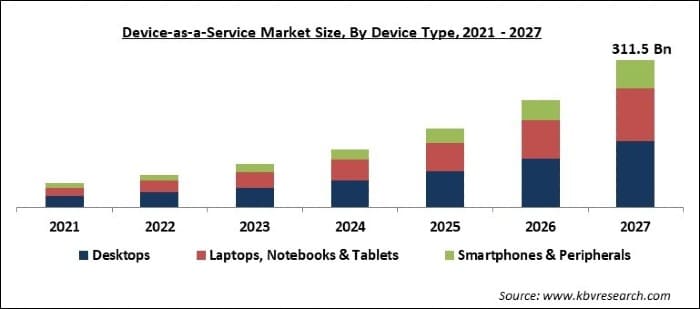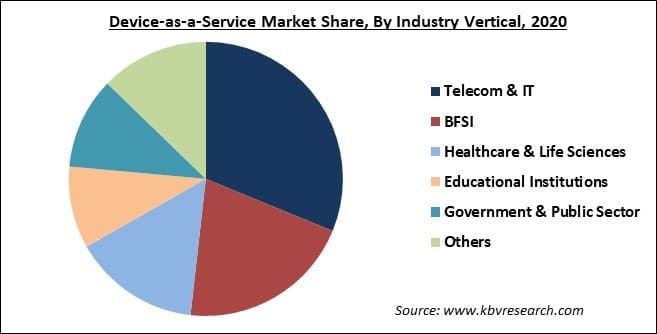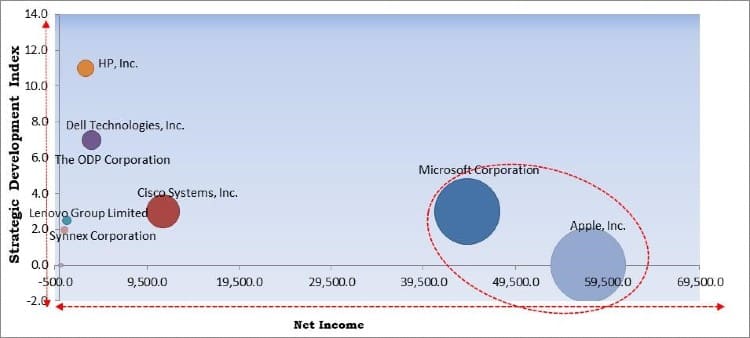The Global Device-as-a-Service Market size is expected to reach $311.5 billion by 2027, rising at a market growth of 35.5% CAGR during the forecast period. The device as a service (DaaS) refers to the management of every type of hardware such as laptops, smartphones, desktops, and others, with software, which is operated on the hardware.
The DaaS vendors provide their services to customers on a contract basis with a monthly subscription fee. In addition, it is a cloud-based delivery model, thereby making it easier for customers to run on their gadgets from any location as this service does not depend on their network, device, and location. This system has an architecture, which helps numerous customers to access a single instance of a software app across the single instance architecture.
The swift adoption of subscription-based service models, greater policy compliance and decrease in help desk volume are estimated to fuel the growth of the market. Additionally, rising demand for DaaS across several industry verticals, growing requirement for cost-efficient solutions, and increasing requirement for highly safe devices & better stability would also surge the market growth during the forecast period. Moreover, aspects like technological improvements, rising advancements of web services, ever-changing business requirements, growing adoption of IoT, and increasing penetration of high-speed internet networks are also anticipated to bolster the growth of the DaaS market.

The swift adoption of the subscription-based services model is among the key factors fueling the device-as-a-service market. These subscription-based DaaS models enabled users to shift from the huge cost of getting the latest technology from a capital expenditure (CapEx) to an operating expense (OpEx). Due to this, several small, mid-sized, and large enterprises can allocate their funds to strategic initiatives, which can generate more revenue.
The global Covid-19 pandemic has affected almost every domain of society. There were several restrictions imposed by the governments across the world, which have some kind of impact on various industries. The DaaS market has witnessed a surge in demand due to the pandemic. It is due to the work-from-home culture, which supported the companies to adopt advanced technologies for the employees working remotely.
The device-as-a-service model is gaining traction among companies because it offers pre-configured hardware like laptops, desktops, tablets, and smartphones, along with customized software. In addition, the outbreak of COVID-19 has led to increased cyberattacks, and remote employees are the major targets for hackers. The device-as-a-service model is very useful since it is an all-inclusive managed solution that has its own cyber defense toolkit. In addition, the service providers are liable to ensure that every device has updated security software and are protected from harmful malware. It also ensures that hardware follows the enterprises' individual security protocols over passwords, approved content, and data logging.

Based on Component, the market is segmented into Hardware, Software and Services. The services segment would witness a high growth rate over the forecast period. The Device-as-a-service model consists of a range of support & maintenance services. In addition, it includes a group of device lifecycle services that involve deployment & integration, installation, repair & maintenance services, and asset recovery services according to the needs of the end-users. Such types of services provide more flexibility as it can be customized and optimized. Several OEMs deliver direct services according to the contract.
Based on Device Type, the market is segmented into Desktops, Laptops, Notebooks & Tablets and Smartphones & Peripherals. Smartphone & Peripherals devices type is estimated to witness the highest growth rate over the forecast period. The DaaS solutions for smartphones provide companies the advantages of reduced costs, access to the latest technologies, better predictable prices, and robust enterprise security. There is an increasing demand for smartphones witnessed in the last few years.
Based on Organization Size, the market is segmented into Small & Medium-sized Enterprises and Large Enterprises. Small & medium-size enterprise is projected to acquire the largest market size in the device-as-a-service market over the forecast period. Small & medium-sized enterprises are increasingly adopting the operating expenses (OpEx) business model above capital expenditure (CapEx). Device-as-a-service helps companies to prioritize their funds by leasing hardware & related services rather than buying high-cost hardware devices.
Based on Industry Vertical, the market is segmented into Telecom & IT, BFSI, Healthcare & Life Sciences, Educational Institutions, Government & Public Sector and Others. The deployment of device-as-a-service in the IT & telecommunication sectors assists the organization to decrease the IT budgets by offering affordable prices for renting of hardware, reduce downtime, and proper management of devices by offering security & software services. Organizations such as Accenture and Sprint Connect utilize device-as-a-service delivered by HP; usage of device-as-a-service solutions assists these enterprises to enhance their efficiency & productivity and also save time & costs.
| Report Attribute | Details |
|---|---|
| Market size value in 2020 | USD 34.9 Billion |
| Market size forecast in 2027 | USD 311.5 Billion |
| Base Year | 2020 |
| Historical Period | 2017 to 2019 |
| Forecast Period | 2021 to 2027 |
| Revenue Growth Rate | CAGR of 35.5% from 2021 to 2027 |
| Number of Pages | 280 |
| Number of Tables | 463 |
| Report coverage | Market Trends, Revenue Estimation and Forecast, Segmentation Analysis, Regional and Country Breakdown, Competitive Landscape, Companies Strategic Developments, Company Profiling |
| Segments covered | Component, Device Type, Organization Size, Industry Vertical, Region |
| Country scope | US, Canada, Mexico, Germany, UK, France, Russia, Spain, Italy, China, Japan, India, South Korea, Singapore, Malaysia, Brazil, Argentina, UAE, Saudi Arabia, South Africa, Nigeria |
| Growth Drivers |
|
| Restraints |
|
Based on Regions, the market is segmented into North America, Europe, Asia Pacific, and Latin America, Middle East & Africa. North America emerged as a leading region of the global device-as-a-service market in 2020. Factor such as the rising demand for device-as-a-service from the IT & telecommunications industry is supporting the growth of the regional market. There are many IT & telecommunication companies like Microsoft, AT&T, and Apple, which are based in this region.

Free Valuable Insights: Global Device-as-a-Service Market size to reach USD 311.5 Billion by 2027
The major strategies followed by the market participants are Product Launches. Based on the Analysis presented in the Cardinal matrix; Microsoft Corporation, and Apple, Inc. are the forerunners in the Device-as-a-Service Market. Companies such as HP, Inc., Dell Technologies, Inc., and The ODP Corporation are some of the key innovators in the market.
The market research report covers the analysis of key stake holders of the market. Key companies profiled in the report include Dell Technologies, Inc., Lenovo Group Limited, Microsoft Corporation, Cisco Systems, Inc., Apple, Inc., HP, Inc., StarHub AG (Asia Mobile Holdings Pte. Ltd.), Synnex Corporation, Softcat PLC, and The ODP Corporation (Compucom).
By Component
By Device Type
By Organization Size
By Industry Vertical
By Geography
Our team of dedicated experts can provide you with attractive expansion opportunities for your business.

